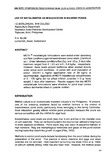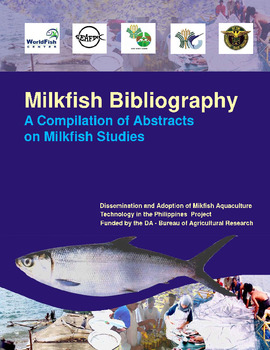Use of metaldehyde as molluscicide in milkfish ponds
- Global styles
- MLA
- Vancouver
- Elsevier - Harvard
- APA
- Help
Share
Abstract
METAR metaldehyde formulations were tested under laboratory and faild conditions againts brackishwater pond snails (certhium so.). Under laboratory conditions the LC50 and LC99 3 days after treatment ranged from 2 - 3.5 and 4.8 - 5.4 kg/ha, respectively. However. these levels proved inffection when applied directly under actual pond conditions. In ponds with snail populatin of about 300/m2, a higher application rate of 30 kg/ha is recommended. Application of META metaldehyde concentrations of 0 - 175 kg/ha did not affect milkfish juveniles (1 - 3g body weight) 7 days after treatment. Results suggest that META metaldehyde formulations were effective for pond snail control without detrimental effect on juvenile milkfish.
Suggested Citation
Borlongan, I. G., Coloso, R. M., & Blum, R. A. (1996). Use of metaldehyde as molluscicide in milkfish ponds. In I. F. Henderson (Ed.), Slug and Snail Pests in Agriculture. Proceedings of a Symposium organized by The British Crop Protection Council in conjunction with The Association of Applied Biologists and The Malacological Society of London, held at the University of Kent Canterbury, UK on 24-26 September 1996 (pp. 205-212). Farnham, Surrey: British Crop Protection Council.
Type
Conference paperCollections
- Conference Proceedings [299]
Related items
Showing items related by title, author, creator and subject.
-
Milkfish bibliography: a compilation of abstracts on milkfish studies
WorldFish Center (WorldFish Center, 2007)Milkfish Bibliography covers 700 references on milkfish biology; broodstock management and fry, fingerling and egg collection and production; milkfish culture systems; health and nutrition; post harvest technology; ... -
Ongoing research studies on maturation and spawning of milkfish, Chanos chanos at the brackishwater shrimp and milkfish culture applied research and training project, Jepara, Indonesia
Alikunhi, K. H. (Aquaculture Department, Southeast Asian Fisheries Development Center, 1976)The paper gives an account of the research work carried out at Jepara, Indonesia, on induction of maturity of milkfish in ponds and enclosures, and procurement of the spawners from the wild for seed production by hypophysation. ... -
Ration reduction, integrated multitrophic aquaculture (milkfish-seaweed-sea cucumber) and value-added products to improve incomes and reduce the ecological footprint of milkfish culture in the Philippines
de Jesus-Ayson, Evelyn Grace T.; Borski, Russel J. (AquaFish Collaborative Research Support Program, Oregon State University, 2012)In the Philippines, cage culture of milkfish in marine environments is increasing. The practice uses high stocking densities, with significantly greater inputs of artificial feeds which more often than not, have led to ...






